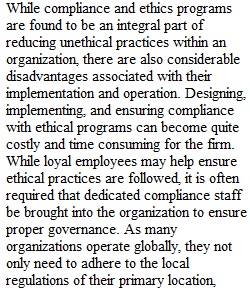


Q MBA 635 Group Short Paper Guidelines and Rubric Read the articles “Why Compliance Programs Fail” and “How to Design an Ethical Organization” from the Shapiro Library. Also, read “A Global Leader’s Guide to Managing Business Conduct” located in your Harvard Business Review module. You will discuss the concepts covered in the articles with your peers, culminating in a short paper. As a team, discuss in the group forum how your team will work together to complete the short paper. As a team, identify a group leader, and then create a timeline and delegate work to complete the paper. The group leader will submit the paper. Specifically, the following critical elements must be addressed: 1. What are the shortcomings of compliance and ethics training programs? 2. What strategies and processes may companies use to monitor business conduct? 3. How can companies use data to standardize ethical organizational culture and maintain a sustainable brand? Rubric Guidelines for Submission: Your paper must follow these formatting guidelines: 2- to 3-page Word document, double spacing, 12-point Times New Roman font, one-inch margins, and APA citations. Critical Elements Exemplary (100%) Proficient (90%) Needs Improvement (70%) Not Evident (0%) Value Compliance and Ethics Meets “Proficient” criteria, and submission demonstrates keen insight supported with details and scholarly sources Clearly identifies how and why compliance and ethics programs of most companies fall short of addressing global business ethical responsibilities Identifies how and why compliance and ethics programs of most companies fall short of addressing global business ethical responsibilities, but submission lacks detail and support Does not identify how and why compliance and ethics programs of most companies fall short of addressing global business ethical responsibilities 30 Strategies and Processes Meets “Proficient” criteria, and submission demonstrates keen insight, supported with details and scholarly sources Thoroughly explains how companies can manage conduct and ethics with strategies and processes to optimize business sustainability Explains how companies can manage conduct and ethics with strategies and processes to optimize business sustainability, but submission lacks detail and support Does not explain how companies can manage conduct and ethics with strategies and processes to optimize business sustainability 30 Critical Elements Exemplary (100%) Proficient (90%) Needs Improvement (70%) Not Evident (0%) Value Sustainable Brand Meets “Proficient” criteria, and submission demonstrates keen insight supported with details and scholarly sources Thoroughly describes how companies can use data to standardize ethical culture and maintain brand development Describes how companies can use data to standardize ethical culture and maintain brand development, but submission lacks detail and support Does not describe how companies can use data to standardize ethical culture and maintain brand development 30 Articulation of Response Submission is free of errors related to citations, grammar, spelling, syntax, and organization and is presented in a professional and easy to read format Submission has no major errors related to citations, grammar, spelling, syntax, or organization Submission has major errors related to citations, grammar, spelling, syntax, or organization that negatively impact readability and articulation of main ideas Submission has critical errors related to citations, grammar, spelling, syntax, or organization that prevent understanding of ideas 10 Total 100%
View Related Questions